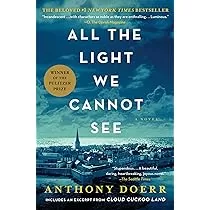“A Page to Screen Hit”

Now A Netflix Limited Series
In the literary world, some stories amaze us with their hidden brilliance, drawing us into a world of mystery and wonder. One such masterpiece is Anthony Doerr’s “All the Light We Cannot See,” a novel that has enchanted readers with its intricate storytelling and vivid imagery.
Exploring the depths of human resilience and the power of connection, “All the Light We Cannot See” takes us on a journey through the lives of two individuals amidst the chaos of World War II. Marie-Laure, a blind French girl, and Werner, a German orphan, find their fates intertwined as they navigate a world torn apart by conflict.
Doerr’s exquisite prose allows us to uncover the hidden layers of symbolism and the profound emotions that resonate throughout the novel. As we delve into the pages of “All the Light We Cannot See,” we discover the intricate web of human experiences that lie beneath the surface, inviting us to contemplate the unseen beauty and resilience that exists in our own lives.
Join us as we embark on a literary exploration, peeling back the layers of “All the Light We Cannot See” to reveal its unseen brilliance.
The Historical Backdrop of the Novel
Set against the harrowing backdrop of World War II, “All the Light We Cannot See” immerses readers in a time of profound turmoil and human suffering. The historical context is meticulously woven into the narrative, providing a rich tapestry that enhances the emotional weight of the characters’ journeys. The novel spans several years, primarily focusing on the period from the late 1930s to the early 1940s, showcasing the devastating effects of war on individual lives and entire communities. The impact of Nazi occupation in France and the repercussions of a divided Europe reverberate throughout the story, influencing the paths of Marie-Laure and Werner.
Through vivid descriptions and poignant details, Anthony Doerr captures the atmosphere of fear, uncertainty, and resilience that permeated life during the war. The struggles faced by ordinary citizens become palpable as the narrative unfolds. Marie-Laure’s world, shaped by her blindness, contrasts sharply with the harsh realities of the war-torn environment surrounding her. Meanwhile, Werner’s journey from an orphan in Germany to a soldier in the Nazi regime highlights the moral complexities and ethical dilemmas faced by individuals caught in the machinery of war. Doerr’s portrayal of the historical backdrop serves as a character in its own right, influencing the decisions and fates of those who inhabit it.
Moreover, the author deftly incorporates real historical events and figures, imbuing the narrative with authenticity. The story reflects the experiences of countless people during this tumultuous period, emphasizing the universality of human suffering and the enduring spirit of hope. The historical backdrop of “All the Light We Cannot See” is a crucial component that enriches the narrative, allowing readers to grasp the magnitude of the characters’ struggles and the profound resilience that emerges amidst chaos and despair.
Key Themes and Motifs in the Book
At its core, “All the Light We Cannot See” is a meditation on the themes of resilience, connection, and the inherent beauty of the human spirit. One of the most prominent themes is the struggle for survival in the face of overwhelming odds. Both Marie-Laure and Werner are forced to navigate a world that is often cruel and unforgiving, yet they exhibit remarkable courage and determination. Their journeys illuminate how individuals can find strength within themselves and forge their paths despite the external forces that seek to oppress them.
Another significant theme is the power of human connection and how love and compassion can transcend barriers. The novel beautifully illustrates how the bonds formed between individuals can shine through the darkness of conflict. Marie-Laure’s relationship with her father, her friendships, and her eventual connection with Werner serves as a testament to the idea that empathy and kindness can flourish even in the direst circumstances. This theme resonates deeply, reminding readers of the importance of human relationships and how they can provide solace and support amid suffering.
Additionally, the motif of light and darkness permeates the narrative, symbolizing hope, knowledge, and the search for truth against the backdrop of ignorance and despair. The title itself evokes the contrast between what is seen and what is unseen, suggesting that there is beauty and brilliance in the world that often goes unnoticed. Through the lens of Marie-Laure’s blindness, Doerr explores the idea that perception is not solely reliant on sight; it encompasses a more profound understanding of the world that transcends the physical. This interplay of light and darkness ultimately invites readers to reflect on the unseen aspects of their lives, encouraging a deeper appreciation for the connections and experiences that illuminate our existence.
Breakdown of the Main Characters
Marie-Laure LeBlanc, one of the novel’s central characters, embodies resilience and courage. Born with blindness, she navigates the world through her other senses, developing a profound understanding of her surroundings despite her visual impairment. Marie-Laure’s journey is marked by her determination to survive in a world that often feels hostile and isolating. Her relationship with her father, who nurtures her independence and imagination, serves as a foundation for her strength. Throughout the novel, she evolves from a sheltered girl into a symbol of hope and perseverance, demonstrating that true vision comes from within.
In contrast, Werner Pfennig represents a different kind of struggle. An orphan with a remarkable talent for engineering, Werner’s intelligence sets him apart, yet it also places him in moral dilemmas as he is recruited into the Nazi regime. His character arc reflects the complexities of choice and consequence; he grapples with the weight of his decisions and the ethical implications of his involvement in the war. Werner’s internal conflict and eventual search for redemption highlight the theme of humanity amidst dehumanization, making him a compelling and relatable figure. His journey intertwines with Marie-Laure’s in unexpected ways, showcasing how their lives converge despite the vast chasm created by war.
The supporting characters also play crucial roles in enriching the narrative. From Marie-Laure’s father, who embodies love and protection, to the enigmatic figure of the German officer von Rumpel, each character contributes to the exploration of themes such as sacrifice, morality, and the quest for truth. Doerr crafts a diverse cast that reflects the multifaceted nature of human experience during wartime. The interplay between these characters not only deepens the emotional resonance of the story but also emphasizes the interconnectedness of their lives, ultimately reinforcing the notion that even in darkness, there exists light through shared experiences and connections.
The Writing Style and Narrative Structure
Anthony Doerr’s writing style in “All the Light We Cannot See” is characterized by its lyrical prose and evocative imagery, which transport readers into the heart of the narrative. His ability to create vivid descriptions allows readers to visualize the settings and emotional landscapes of the characters. The careful attention to detail enhances the reader’s immersion, making the experiences of Marie-Laure and Werner feel immediate and tangible. Doerr’s use of sensory language is particularly striking, as it resonates with Marie-Laure’s perspective, emphasizing her acute awareness of the world around her despite her blindness.
The narrative structure of the novel is non-linear, alternating between different periods and perspectives. This technique adds depth to the storytelling, allowing readers to piece together the characters’ histories and the events that shape their lives. The shifts in time create a sense of suspense, as readers gradually uncover the connections between Marie-Laure and Werner. This intricate weaving of timelines reflects the complexities of memory and experience, highlighting how past events influence present realities. Doerr’s masterful manipulation of time and perspective encourages readers to engage actively with the narrative, piecing together the puzzle of the characters’ intertwined fates.
Moreover, the novel’s pacing is meticulous, balancing moments of tension with poignant reflections. Doerr’s ability to oscillate between the urgency of wartime events and the quiet introspection of his characters creates a rich emotional tapestry. The interplay of action and contemplation allows for a deeper exploration of the themes of resilience and connection, inviting readers to reflect on their own experiences in the context of the narrative. Through this thoughtful writing style and narrative structure, Doerr crafts a story that resonates on multiple levels, leaving a lasting impact long after the final page is turned.
The Symbolism and Imagery in the Novel
Symbolism and imagery play a crucial role in enriching the narrative of “All the Light We Cannot See,” allowing for deeper exploration of its themes. One of the most prominent symbols in the novel is the Sea of Flames, a legendary diamond that represents both beauty and destruction. The diamond’s allure draws characters into a web of greed and desire, while its cursed nature serves as a reminder of the consequences of obsession. This duality encapsulates the broader themes of war and the human condition, illustrating how beauty can coexist with suffering.
Imagery is also employed masterfully to evoke the contrasting landscapes of the novel. The descriptions of Paris, with its intricate streets and vibrant life, stand in stark contrast to the desolation of wartime Germany. Doerr’s use of sensory details creates a visceral experience for readers, allowing them to feel the atmosphere of each setting. The imagery of light and darkness is particularly poignant, symbolizing hope amidst despair. Marie-Laure’s experiences in the dark are often juxtaposed with moments of illumination, emphasizing the idea that light can emerge from even the most challenging circumstances.
Furthermore, the motif of maps serves as a powerful symbol throughout the narrative. For Marie-Laure, maps represent her understanding of the world, guiding her through the obstacles that her blindness presents. They symbolize the quest for knowledge and the desire for connection to a place and its history. As the characters navigate their respective journeys, the maps also reflect the larger search for meaning and purpose amidst the chaos of war. Doerr’s use of symbolism and imagery enriches the reader’s experience, inviting contemplation of the deeper layers of meaning embedded within the narrative.
Critical Reception and Awards
“All the Light We Cannot See” has garnered widespread critical acclaim since its publication, earning a place among contemporary literary masterpieces. Reviewers have praised Anthony Doerr’s ability to weave a poignant story that resonates with readers on both emotional and intellectual levels. The novel’s exploration of the human experience during wartime, coupled with its lyrical prose, has captivated audiences and critics alike. Renowned literary publications have lauded the book for its intricacy and depth, often highlighting its rich thematic content as a significant achievement in modern literature.
In recognition of its outstanding contribution to the literary world, “All the Light We Cannot See” has received numerous prestigious awards. Most notably, it was awarded the Pulitzer Prize for Fiction in 2015, a testament to Doerr’s exceptional storytelling and the novel’s impact on readers and critics. Additionally, the book has been recognized by various literary organizations and has appeared on numerous bestseller lists, further solidifying its status as a beloved work. The accolades serve not only as recognition of Doerr’s talent but also as a reflection of the novel’s resonance with themes of resilience, connection, and the enduring human spirit.
The critical reception of “All the Light We Cannot See” has also sparked discussions about its relevance in contemporary society. Many readers find the themes of the novel—such as the consequences of conflict, the power of empathy, and the search for meaning—particularly resonant in today’s world. The book has been embraced by educators, who often incorporate it into curricula to foster discussions about history, ethics, and the human condition. Through its accolades and ongoing relevance, the novel continues to inspire readers and provoke thoughtful discourse, underscoring the enduring power of literature to illuminate the complexities of our shared experiences.
Trolling the Deeper Meaning of the Title
The title “All the Light We Cannot See” serves as a profound metaphor for the themes of the novel, encapsulating the essence of human experience amidst the darkness of war. At first glance, the phrase suggests the contrast between sight and blindness, yet it transcends this simple dichotomy. The “light” symbolizes hope, knowledge, and the beauty that exists in the world, often hidden beneath the surface of despair and conflict. The notion of “not seeing” extends beyond the literal interpretation, inviting readers to contemplate the unseen struggles and triumphs of individuals navigating their realities.
Marie-Laure’s blindness becomes a powerful lens through which the narrative unfolds. While she cannot perceive the world visually, her acute awareness of her surroundings and her rich inner life reveals a different kind of vision. This theme encourages readers to consider how perception shapes our understanding of the world. The idea that there is more to life than what meets the eye resonates deeply, suggesting that true insight often comes from emotional and experiential understanding rather than mere observation. The title reflects the complexities of human existence, urging readers to look beyond the superficial and recognize the profound connections and experiences that define our lives.
Additionally, the title speaks to the broader human condition, encapsulating the struggles faced by individuals during times of conflict. The “light” can be interpreted as the resilience of the human spirit, which persists even when overshadowed by darkness. It symbolizes the moments of joy, love, and connection that continue to exist despite the challenges faced by the characters. In this way, the title serves as a poignant reminder that even in the bleakest circumstances, there are glimpses of light that illuminate the path forward. “All the Light We Cannot See” invites readers to seek out and appreciate the unseen brilliance in their lives, encouraging a deeper understanding of the world around them.
The Lasting Impact and Legacy of “All the Light We Cannot See”
The legacy of “All the Light We Cannot See” extends far beyond its initial publication, as it continues to resonate with readers across generations. Its exploration of themes such as resilience, connection, and the human experience during wartime has made it a timeless work that speaks to the challenges of the human condition. The novel’s ability to evoke empathy and understanding fosters discussions about morality, ethics, and the consequences of conflict, making it relevant in today’s world. As readers grapple with contemporary issues, the lessons gleaned from Doerr’s narrative serve as a reminder of the enduring power of literature to illuminate the complexities of life.
Moreover, the book has inspired various adaptations and artistic interpretations, further solidifying its place in the cultural landscape. From book clubs to academic discussions, “All the Light We Cannot See” has sparked conversations that explore the intricacies of war, the importance of human connections, and the search for meaning amidst chaos. Its inclusion in educational curricula highlights the novel’s impact as a teaching tool, encouraging critical thinking and empathy among students. The lasting impact of the novel lies in its ability to provoke thought and inspire a deeper understanding of the world.
In an age where the lessons of history are often overlooked, “All the Light We Cannot See” serves as a poignant reminder of the resilience of the human spirit. Anthony Doerr’s masterful storytelling invites readers to reflect on their own lives and the unseen brilliance that exists within their experiences. As new audiences discover the novel, its legacy continues to grow, proving that literature has the power to transcend time and space, forging connections that unite us in our shared humanity. The enduring impact of “All the Light We Cannot See” is a testament to the profound influence of storytelling in shaping our understanding of ourselves and the world around us.
Why This Book is a Must-Read
In conclusion, “All the Light We Cannot See” is a literary masterpiece that transcends the boundaries of time and place, inviting readers into a world rich with emotion, resilience, and connection. Anthony Doerr’s intricate storytelling, coupled with his lyrical prose, creates a narrative that resonates deeply and lingers in the hearts of those who engage with it. The exploration of profound themes, such as the struggle for survival and the power of human connection, makes this novel not only a compelling read but also a powerful reflection on the human experience.
The characters of Marie-Laure and Werner serve as vessels through which we experience the complexities of war and the enduring spirit of hope. Their journeys remind us of the importance of empathy and understanding, encouraging readers to look beyond the surface and appreciate the unseen brilliance in our own lives. The novel’s rich symbolism and imagery further enhance its emotional depth, inviting contemplation and introspection.
As readers continue to grapple with the challenges of the contemporary world, “All the Light We Cannot See” remains relevant and poignant. It serves as a reminder of the resilience of the human spirit, urging us to seek out the light in times of darkness. For anyone seeking a profound and transformative reading experience, this novel is undoubtedly a must-read, offering insights that resonate long after the final page is turned. Through its exploration of the unseen depths of human existence, Doerr’s masterpiece inspires hope and encourages reflection, making it a timeless work that deserves a place in every reader’s heart.













































































































